Multisensor Characterization of the Incandescent Jet Region of Lava Fountain-Fed Tephra Plumes
Abstract
1. Introduction
2. Instruments
2.1. Thermal Infrared Camera
2.2. The L-Band VOLDORAD-2B Doppler Radar
2.3. The X-Band Polarimetric Weather Radar
3. Methods
3.1. Thermal-Infrared Camera Algorithms
3.2. Simulated X-Band Radar Responses
- (i).
- The reflectivity factor Zhh, expressed in units of mm6 m−3 or commonly as decibels dBZ. Zhh, is equal within Rayleigh scattering conditions to the integral of the sixth-order moment of the detected particle size distribution, i.e., N(D)D6dD, with N(D) the number distribution (m−3) of particle with diameter D (mm) and size interval dD (mm);
- (ii).
- The differential reflectivity Zdr related to the ratio of reflectivity between the horizontal and vertical polarizations, expressed in dB;
- (iii).
- The copolar correlation coefficient ρhv is a measure of the correlation degree between horizontally and vertically polarized echoes, hence a measure of the variety of particle shapes in a pulse volume between horizontal (H) and vertical (V) polarization radar returns [33].
3.3. Microwave Radar Algorithms
- (1)
- Exploring X-band radar data potential to detect and estimate the height of the IJR from its polarimetric signatures.
- (2)
- Integrating X-band radar estimates with the IJR height retrievals from L-band estimates used as a constraint.
- (3)
- Comparing X-band radar and TIR camera observations in order to better understand the link between the IJR and the lava fountains and to reduce errors in their respective IJR height estimates.
4. Etna Case Studies
4.1. Paroxysm of 23 November 2013
4.2. Paroxysms on 3–5 December 2015
5. Results
6. Conclusions
Author Contributions
Funding
Acknowledgments
Conflicts of Interest
References
- Du Preez, D.V.; Bencherif, H.; Bègue, N.; Clarisse, L.; Hoffman, R.F.; Wright, C.Y. Investigating the Large-Scale Transport of a Volcanic Plume and the Impact on a Secondary Site. Atmosphere 2020, 11, 548. [Google Scholar] [CrossRef]
- Sparks, R.S.J. The dimensions and dynamics of volcanic eruption columns. Bull. Volcanol. 1986, 48, 3–15. [Google Scholar] [CrossRef]
- Woodhouse, M.J.; Hogg, A.J.; Phillips, J.C. A global sensitivity analysis of the PlumeRise model of volcanic plumes. J. Volcanol. Geotherm. Res. 2016, 326, 54–76. [Google Scholar] [CrossRef]
- Self, S. The effects and consequences of very large explosive volcanic eruptions. Philos. Trans. R. Soc. A Math. Phys. Eng. Sci. 2006, 364, 2073–2097. [Google Scholar] [CrossRef] [PubMed]
- Carazzo, G.; Kaminski, E.; Tait, S. On the dynamics of volcanic columns: A comparison of field data with a new model of negatively buoyant jets. J. Volcanol. Geotherm. Res. 2008, 178, 94–103. [Google Scholar] [CrossRef]
- Suzuki, Y.J.; Koyaguchi, T. A three-dimensional numerical simulation of spreading umbrella clouds. J. Geophys. Res. 2009, 114, B03209. [Google Scholar] [CrossRef]
- Esposti Ongaro, T.; Clarke, A.B.; Neri, A.; Voight, B.; Widiwijayanti, C. Fluid dynamics of the 1997 Boxing Day volcanic blast on Montserrat, West Indies. J. Geophys. Res. 1995, 113, B03211. [Google Scholar] [CrossRef]
- Wilson, L.; Parfitt, E.A.; Head, J.W. Explosive volcanic eruptions—VIII. The role of magma recycling in controlling the behaviour of Hawaiian-style lava fountains. Geophys. J. Int. 1995, 121, 215–225. [Google Scholar] [CrossRef]
- Taddeucci, J.; Edmonds, M.; Houghton, B.; James, M.R.; Vergniolle, S. Hawaiian and Strombolian Eruptions. The Encyclopedia of Volcanoes; Elsevier Inc.: Amsterdam, The Netherland; University of Rhode Island: Narragansett, RI, USA, 2015; pp. 485–503. [Google Scholar]
- Snee, E.; Degruyter, W.; Bonadonna, C.; Scollo, S.; Rossi, E.; Freret-Lorgeril, V. A model for buoyant tephra plumes coupled to lava fountains with an application to paroxysmal eruptions at Mount Etna. JGR Solid Earth 2020. submitted. [Google Scholar]
- Bonadonna, C.; Folch, A.; Loughlin, S.; Puempel, H. Future developments in modelling and monitoring of volcanic ash clouds: Outcomes from the first IAVCEI-WMO workshop on Ash Dispersal Forecast and Civil Aviation. Short Sci. Commun. Bull. Volcanol. 2011, 74, 1–10. [Google Scholar] [CrossRef]
- Marzano, F.S.; Picciotti, E.; Vulpiani, G.; Montopoli, M. Synthetic signatures of volcanic ash cloud particles from X-band dual-polarization radar. IEEE Trans. Geosci. Remote Sens. 2012, 50, 193–211. [Google Scholar] [CrossRef]
- Mereu, L.; Marzano, F.S.; Montopoli, M.; Bonadonna, C. Retrieval of tephra size spectra and mass flow rate from C-Band radar during the 2010 Eyjafjallajökull eruption, Iceland. IEEE Trans. Geosci. Remote Sens. 2015, 3, 5644–5660. [Google Scholar] [CrossRef]
- Scollo, S.; Prestifilippo, M.; Bonadonna, C.; Cioni, R.; Corradini, S.; Degruyter, W.; Rossi, E.; Silvestri, M.; Biale, E.; Carparelli, G. Near-Real-Time Tephra Fallout Assessment at Mt. Etna, Italy. Remote Sens. 2019, 11, 2987. [Google Scholar] [CrossRef]
- Ripepe, M.; Bonadonna, C.; Folch, A.; Delle Donne, D.; Lacanna, G.; Marchetti, E.; Hoskuldsson, A. Ash-plume dynamics and eruption source parameters by infrasound and thermal imagery: The 2010 Eyjafjallajokull eruption. Earth Planet. Sci. Lett. 2013, 366, 112–121. [Google Scholar] [CrossRef]
- Donnadieu, F. Volcanological applications of Doppler radars: A review and examples from a transportable pulse radar in L-band. In Doppler Radar Observations-Weather Radar, Wind Profiler, Ionospheric Radar, and Other Advanced Applications; Bech, J., Chau, J.L., Eds.; InTech: London, UK, 2012; pp. 409–446. ISBN 978-953-51-0496-4. [Google Scholar]
- Freret-Lorgeril, V.; Donnadieu, F.; Scollo, S.; Provost, A.; Fréville, P.; Guéhenneux, Y.; Hervier, C.; Prestifilippo, M.; Coltelli, M. Mass eruption rates of tephra plumes during the 2011–2015 lava fountain paroxysms at Mt. Etna from Doppler radar retrievals. Front. Earth Sci. 2018, 6. [Google Scholar] [CrossRef]
- Marzano, F.S.; Barbieri, S.; Vulpiani, G.; Rose, I.W. Volcanic Ash Cloud Retrieval by Ground-Based Microwave Weather Radar. IEEE Trans. Geosci. Remote Sens. 2006, 44, 11. [Google Scholar] [CrossRef]
- Scollo, S.; Prestifilippo, M.; Spata, G.; D’Agostino, M.; Coltelli, M. Monitoring and forecasting Etna volcanic plume. Nat. Hazards Earth Syst. Sci. 2009, 9, 1573–1585. [Google Scholar] [CrossRef]
- Calvari, S.; Cannavò, F.; Bonaccorso, A.; Spampinato, L.; Pellegrino, A.G. Paroxysmal Explosions, Lava Fountains and Ash plumes at Etna Volcano: Eruptive Processes and Hazard Implications. Front. Earth Sci. 2018, 6, 107. [Google Scholar] [CrossRef]
- Corradini, S.; Montopoli, M.; Guerrieri, L.; Ricci, M.; Scollo, S.; Merucci, L.; Marzano, F.S.; Pugnaghi, S.; Prestifilippo, M.; Ventress, L.; et al. A multi-sensor approach for the volcanic ash cloud retrievals and eruption characterization. Remote Sens. 2016, 8, 58. [Google Scholar] [CrossRef]
- Bonaccorso, A.; Calvari, S.; Linde, A.; Sacks, S. Eruptive processes leading to the most explosive lava fountain at Etna volcano: The 23 November 2013 episode. Geophys. Res. Lett. 2014, 41, 4912–4919. [Google Scholar] [CrossRef]
- Carbone, D.; Zuccarello, L.; Messina, A.; Scollo, S.; Rymer, H. Balancing bulk gas accumulation and gas output before and during lava fountaining episodes at Mt. Etna. Nat. Sci. Rep. 2015. [Google Scholar] [CrossRef]
- Sciotto, M.; Cannata, A.; Prestifilippo, M.; Scollo, S.; Fee, D.; Privitera, E. Unravelling the links between seismo-acoustic signals and eruptive parameters: Etna lava fountain case study. Nature 2019, 9, 16417. [Google Scholar] [CrossRef] [PubMed]
- Marzano, F.S.; Mereu, L.; Scollo, S.; Donnadieu, F.; Bonadonna, C. Tephra Mass Eruption Rate from Ground-Based X-Band and L-Band Microwave Radars During the November 23, 2013, Etna Paroxysm. IEEE Trans. Geosci. Remote Sens. 2019, 58, 3314–3327. [Google Scholar] [CrossRef]
- Sparks, R.S.J.; Bursik, M.I.; Carey, S.N.; Gilbert, J.S.; Glaze, L.S.; Sigurdsson, H.; Woods, A.W. Volcanic Plumes; John Wiley & Sons: West Sussex, UK, 1997; 574p. [Google Scholar]
- Calvari, S.; Salerno, G.G.; Spampinato, L.; Gouhier, M.; La Spina, A.; Pecora, E.; Harris, A.J.L.; Labazuy, P.; Biale, E.; Boschi, E. An unloading foam model to constrain Etna’s 11–13 January 2011 lava fountaining episode. J. Geophys. Res. 2011, 116, B11207. [Google Scholar] [CrossRef]
- Behncke, B.; Falsaperla, S.; Pecora, E. Complex magma dynamics at Mount Etna revealed by seismic, thermal and volcanological data. J. Geophys. Res. Atmos. 2009. [Google Scholar] [CrossRef]
- Delle Donne, D.; Ripepe, M. High-frame rate thermal imagery of Strombolian explosions: Implications for explosive and infrasonic source dynamics. J. Geophys. Res. 2012, 117, B09206. [Google Scholar] [CrossRef]
- Vulpiani, G.; Ripepe, M.; Valade, S. Mass discharge rate retrieval combining weather radar and thermal camera observations. J. Geophys. Res. Solid Earth 2016, 121, 5679–5695. [Google Scholar] [CrossRef]
- Montopoli, M.; Vulpiani, G.; Cimini, D.; Picciotti, E.; Marzano, F.S. Interpretation of observed microwave signatures from ground dual polarization radar and space multi-frequency radiometer for the 2011 Grimsvotn volcanic eruption. Atmos. Meas. Tech. 2014, 7, 537–552. [Google Scholar] [CrossRef]
- Canny, J. A Computational Approach to Edge Detection. IEEE Trans. Pattern Anal. Mach. Intell. 1986, PAMI-8, 679–698. [Google Scholar] [CrossRef]
- Mereu, L.; Scollo, S.; Mori, S.; Boselli, A.; Leto, G.; Marzano, F.S. Maximum-Likelihood Retrieval of Volcanic Ash Concentration and Particle Size from Ground-Based Scanning Lidar. IEEE Trans. Geosci. Remote Sens. 2018, 56, 5824–5842. [Google Scholar] [CrossRef]
- Fisher, R.V.; Schmincke, H.-U. Pyroclastic Rocks; Springer: New York, NY, USA, 1984; 472p. [Google Scholar]
- White, J.D.L.; Houghton, B.F. Primary volcaniclastic rocks. Geology 2006, 34, 677–680. [Google Scholar] [CrossRef]
- Mishchenko, M.I. Calculation of the amplitude matrix for a nonspherical particle in a fixed orientation. Appl. Opt. 2001, 39, 1026–1031. [Google Scholar] [CrossRef] [PubMed]
- Hamilton, C.W.; Fitch, E.P.; Fagents, S.A.; Thordarson, T. Rootless tephra stratigraphy and emplacement processes. Bull Volcanol. 2017, 79, 11. [Google Scholar] [CrossRef]
- Donnadieu, F.; Freville, P.; Hervier, C.; Coltelli, M.; Scollo, S.; Prestifilippo, M.; Valade, S.; Rivet, S.; Cacault, P. Near-source Doppler radar monitoring of tephra plumes at Etna. J. Volcanol. Geotherm. Res. 2016, 312, 26–39. [Google Scholar] [CrossRef]
- Ulivieri, G.; Ripepe, M.; Marchetti, E. Infrasound reveals transition to oscillatory discharge regime during lava fountaining: Implication for early warning. Geophys. Res. Lett. 2013, 40, 3008–3013. [Google Scholar] [CrossRef]
- Scollo, S.; Prestifilippo, M.; Pecora, E.; Corradini, S.; Merucci, L.; Spata, G.; Coltelli, M. Eruption column height estimation of the 2011–2013 Etna lava fountains. Ann. Geophys. 2014, 57, S0214. [Google Scholar] [CrossRef]
- Coltelli, M.; Miraglia, L.; Scollo, S. Characterization of shape and 816 terminal velocity of tephra particles erupted during the 2002 eruption 817 of Etna volcano, Italy. Bull. Volcanol. 2008, 70, 1103–1112. [Google Scholar] [CrossRef]
- Andronico, D.; Scollo, S.; Cristaldi, A. Unexpected hazards from tephra fallouts at Mt Etna: The 23 November 2013 lava fountain. J. Volcanol. Geotherm. Res. 2015, 304, 118–125. [Google Scholar] [CrossRef]
- Montopoli, M. Velocity profiles inside volcanic clouds from three- dimensional scanning microwave dual-polarization Doppler radars. J. Geophys. Res. Atmos. 2016, 121, 7881–7900. [Google Scholar] [CrossRef]
- Poret, M.; Corradini, S.; Merucci, L.; Costa, A.; Andronico, A.; Montopoli, M.; Vulpiani, G.; Freret-Lorgeril, V. Reconstructing volcanic plume evolution integrating satellite and ground-based data: Application to the 23rd November 2013 Etna eruption. Atmos. Chem. Phys. Discuss. 2017. [Google Scholar] [CrossRef]
- Pompilio, M.; Bertagnini, A.; Del Carlo, P.; Di Roberto, A. Magma dynamics within a basaltic conduit revealed by textural and compositional features of erupted ash: The December 2015 Mt. Etna Paroxysms. Sci. Rep. 2017, 7, 4805. [Google Scholar] [CrossRef] [PubMed]
- Bringi, V.N.; Chandrasekar, V. Polarimetric Doppler Weather Radar; Cambridge University Press: Cambridge, UK, 2011; p. 636. [Google Scholar]
- De Beni, E.B.; Behncke, S.; Branca, I.; Nicolosi, R.; Carluccio, F.; D’Ajello, C.; Chiappini, M. The continuing story of Etna’s New Southeast Crater (2012–2014): Evolution and volume calculations based on field surveys and aerophotogrammetry. J. Volcanol. Geotherm. Res. 2015, 303, 175–186. [Google Scholar] [CrossRef]
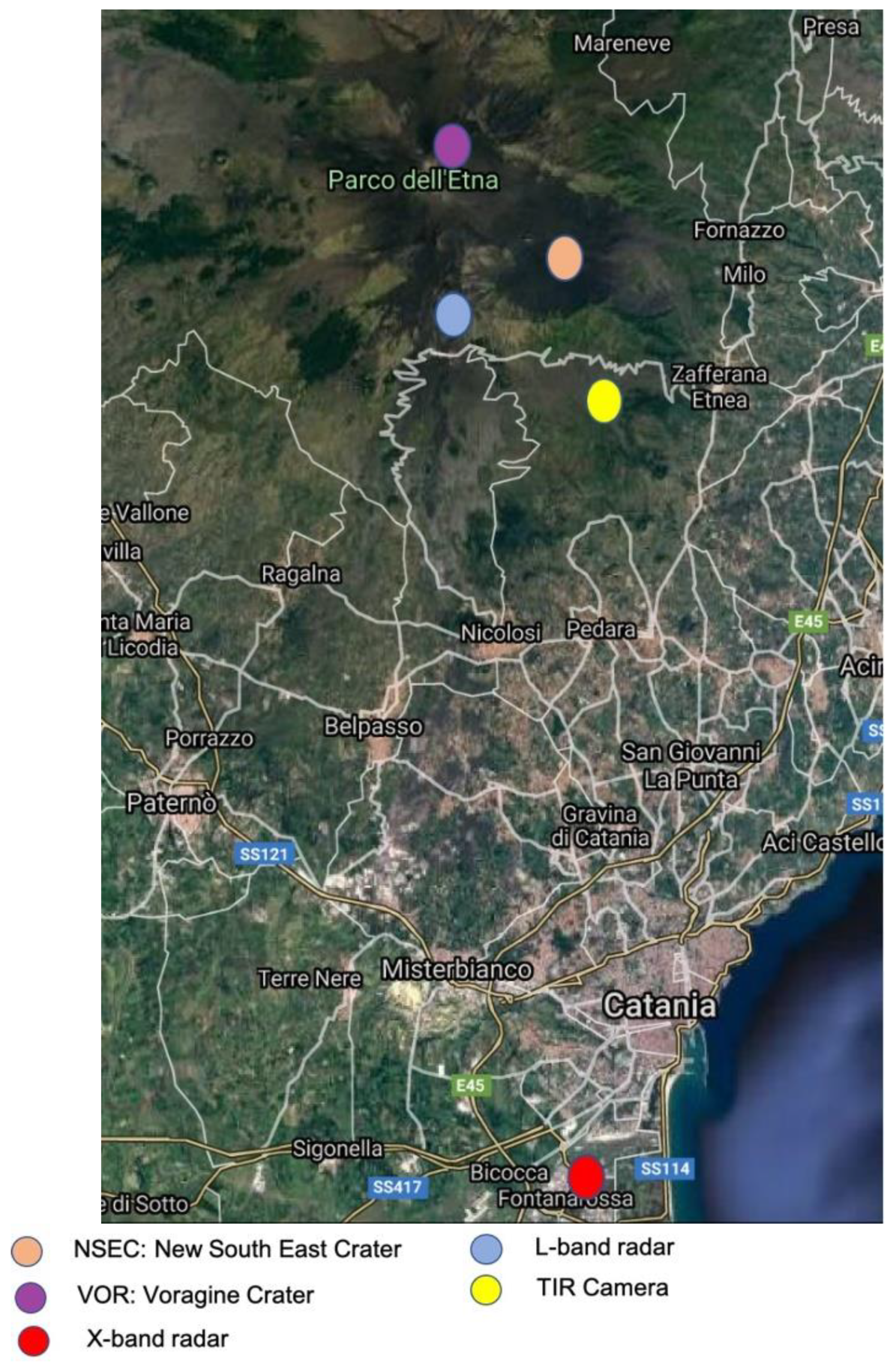
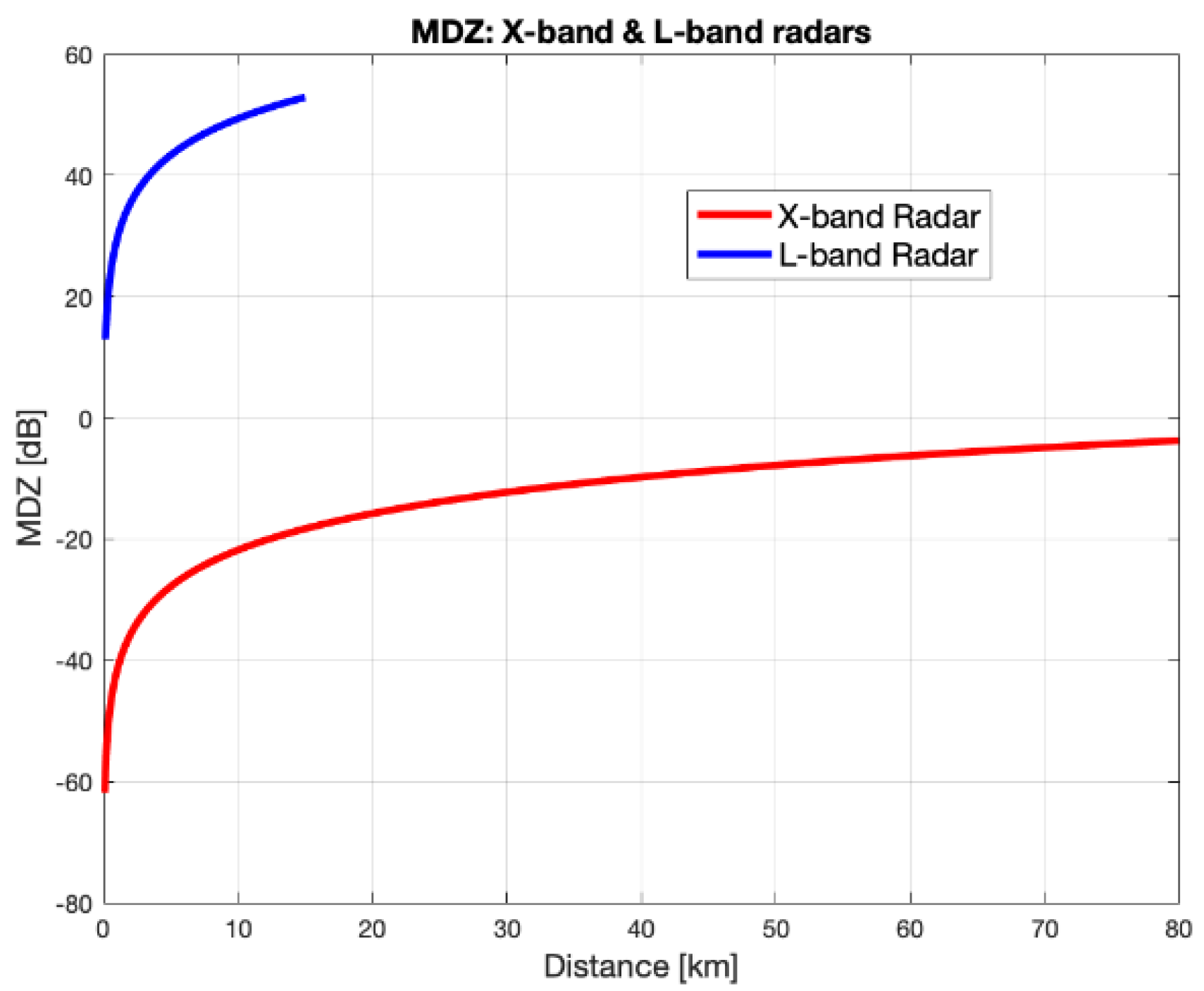
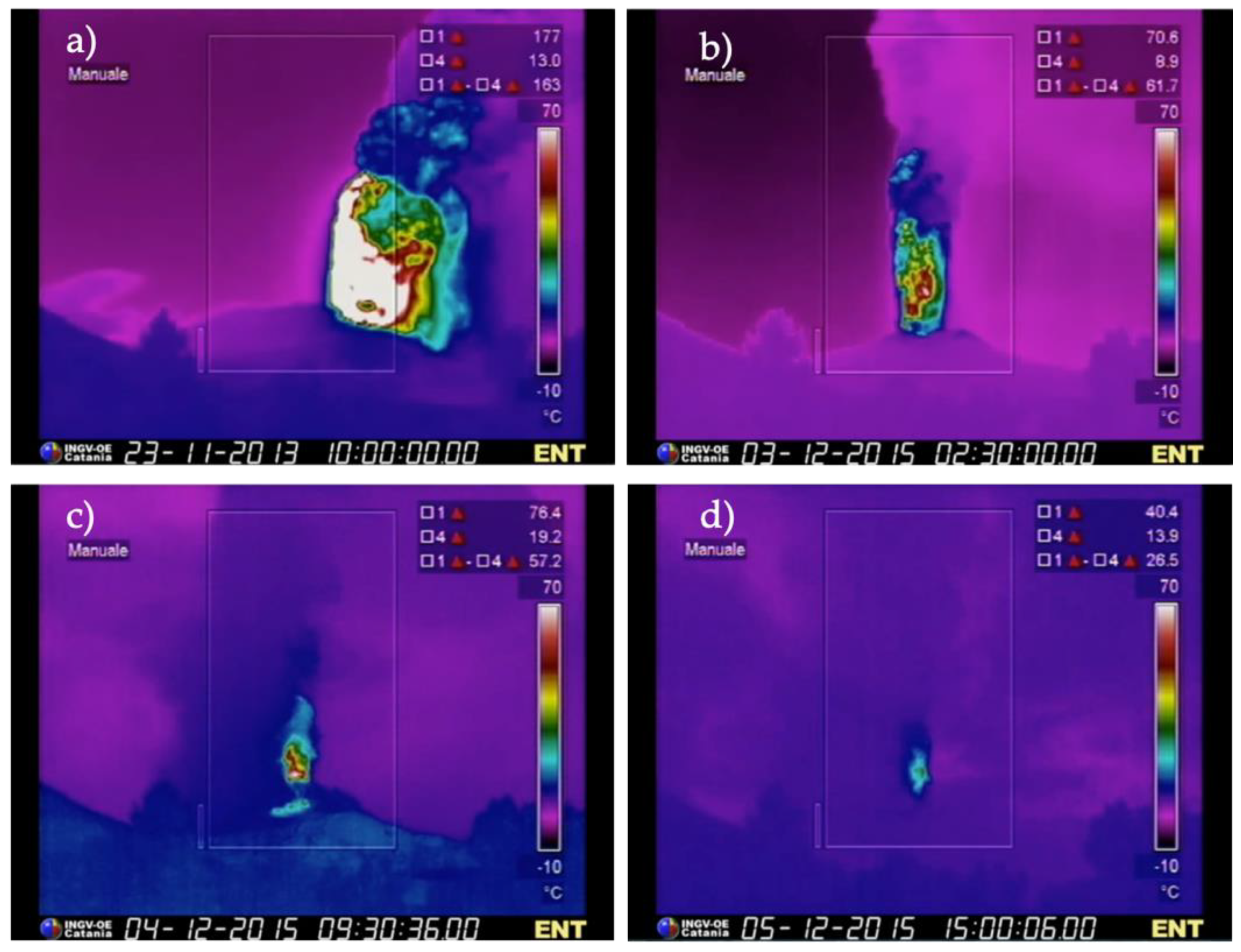


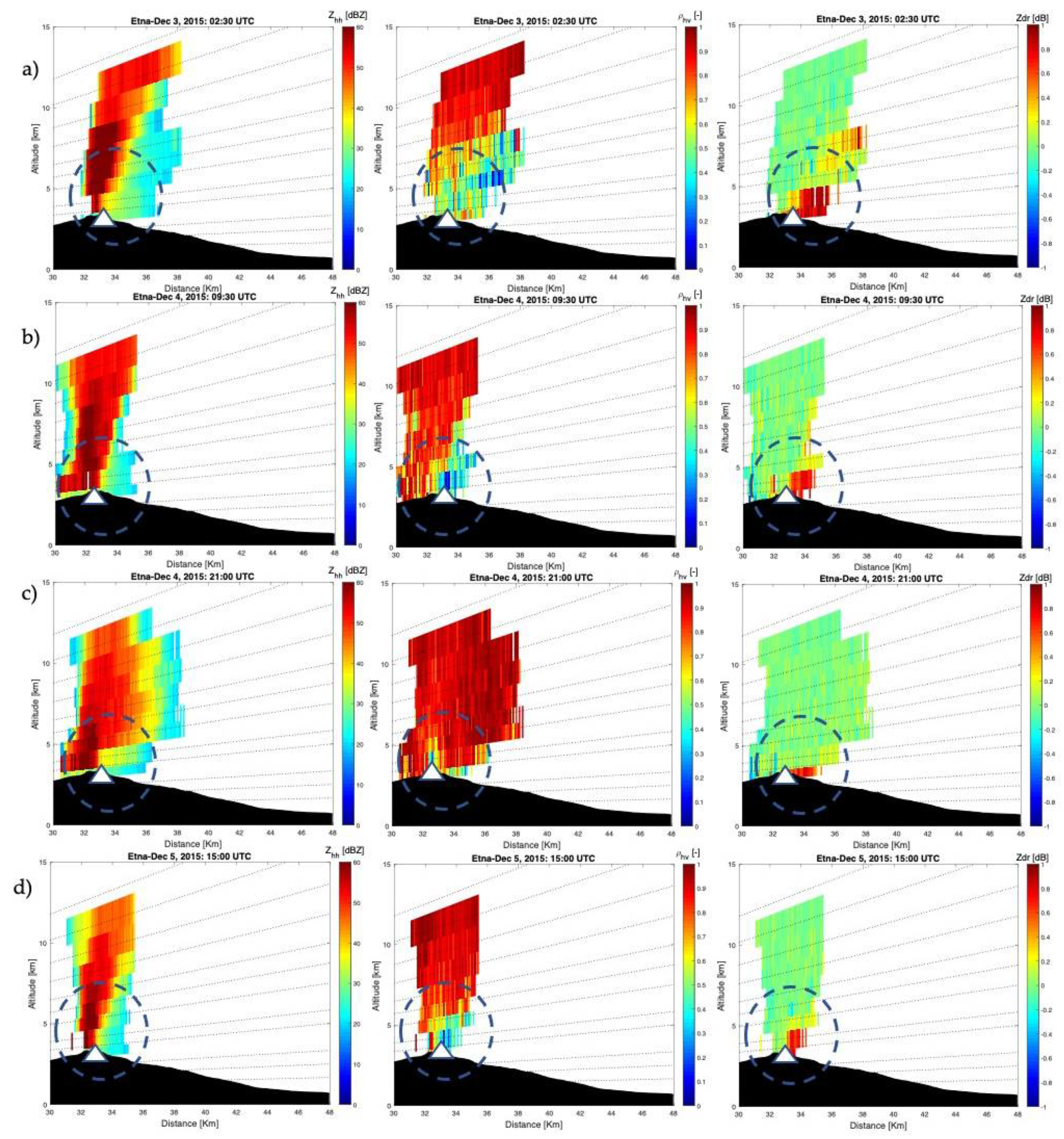

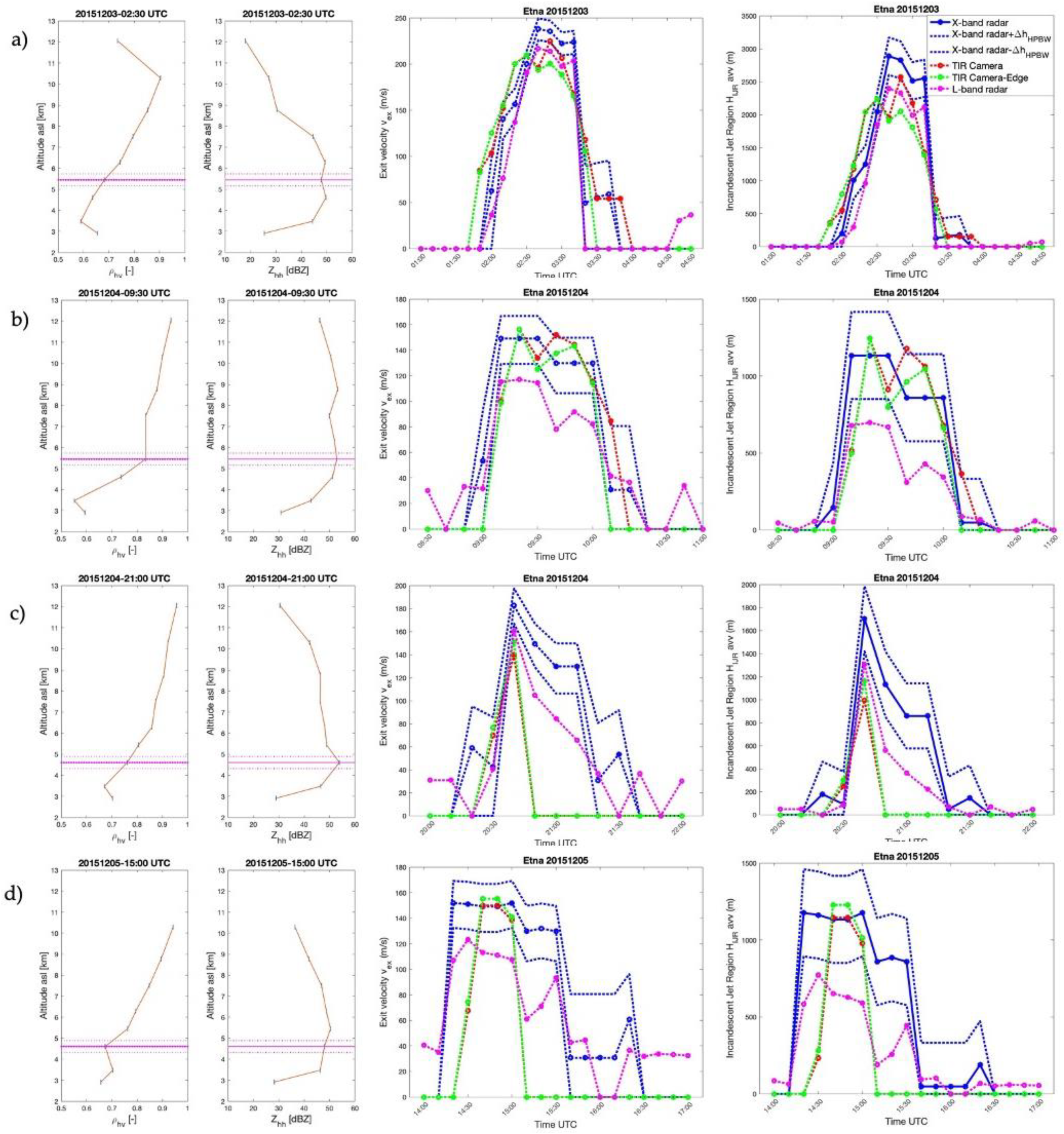

| Threshold | Value |
|---|---|
| tTIR (K) | >315 |
| tT1 | 0.45 |
| tT2 | 0.35 |
Publisher’s Note: MDPI stays neutral with regard to jurisdictional claims in published maps and institutional affiliations. |
© 2020 by the authors. Licensee MDPI, Basel, Switzerland. This article is an open access article distributed under the terms and conditions of the Creative Commons Attribution (CC BY) license (http://creativecommons.org/licenses/by/4.0/).
Share and Cite
Mereu, L.; Scollo, S.; Bonadonna, C.; Freret-Lorgeril, V.; Marzano, F.S. Multisensor Characterization of the Incandescent Jet Region of Lava Fountain-Fed Tephra Plumes. Remote Sens. 2020, 12, 3629. https://doi.org/10.3390/rs12213629
Mereu L, Scollo S, Bonadonna C, Freret-Lorgeril V, Marzano FS. Multisensor Characterization of the Incandescent Jet Region of Lava Fountain-Fed Tephra Plumes. Remote Sensing. 2020; 12(21):3629. https://doi.org/10.3390/rs12213629
Chicago/Turabian StyleMereu, Luigi, Simona Scollo, Costanza Bonadonna, Valentin Freret-Lorgeril, and Frank Silvio Marzano. 2020. "Multisensor Characterization of the Incandescent Jet Region of Lava Fountain-Fed Tephra Plumes" Remote Sensing 12, no. 21: 3629. https://doi.org/10.3390/rs12213629
APA StyleMereu, L., Scollo, S., Bonadonna, C., Freret-Lorgeril, V., & Marzano, F. S. (2020). Multisensor Characterization of the Incandescent Jet Region of Lava Fountain-Fed Tephra Plumes. Remote Sensing, 12(21), 3629. https://doi.org/10.3390/rs12213629







